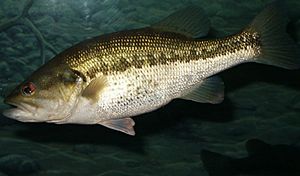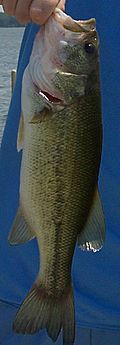Largemouth bass facts for kids
Quick facts for kids Largemouth bass |
|
|---|---|
 |
|
 |
|
| Conservation status | |
| Scientific classification | |
| Genus: |
Micropterus
|
| Species: |
salmoides
|
| Synonyms | |
|
|
The largemouth bass (Micropterus salmoides) is a popular gamefish that eats other animals. It lives in freshwater and belongs to the Centrarchidae family, also known as sunfish. This fish is naturally found in the eastern and central United States, southeastern Canada, and northern Mexico. However, people have moved it to many other places around the world.
This fish has many different names depending on where you are. Some common names include widemouth bass, bigmouth bass, black bass, and bucketmouth. It is also the official state fish for Georgia and Mississippi. For Florida and Alabama, it is their official state freshwater fish.
The largemouth bass is usually olive-green to greenish-gray. A French scientist named Bernard Germain de Lacépède first described it in 1802. It is the biggest type of bass. The longest one ever measured was about 29.5 inches (75 cm) long. The heaviest unofficial weight recorded was 25 pounds 1 ounce (11.36 kg).
Largemouth bass eat many things like smaller fish, worms, snails, and frogs. They like to live in places with lots of underwater plants. In the wild, they usually live for 10 to 16 years. They lay their eggs in the spring when the water gets warm. Many people enjoy fishing for them because they put up a strong fight when caught.
Even though they are popular for fishing, largemouth bass can cause problems. When they are introduced to new areas, they can become an invasive species. This means they might eat or compete with native fish, causing those populations to shrink or even disappear.
Contents
What Largemouth Bass Look Like
The largemouth bass is an olive-green or greenish-gray fish. It has a row of dark, sometimes black, blotches. These blotches form a jagged stripe along each side of its body. Its upper jaw extends past the back of its eye.
This fish is the largest of the black basses. The longest one ever recorded was about 29.5 inches (75 cm) long. The heaviest unofficial weight was 25 pounds 1 ounce (11.36 kg). Female bass are usually bigger than males. On average, they live for 10 to 16 years in the wild.
What Largemouth Bass Eat
Largemouth bass usually stay in small areas in lakes that have many plants underwater. Young bass mostly eat small bait fish, tiny crustaceans like scuds and water fleas, and insects. Adult bass eat bigger things. Their diet includes smaller fish like bluegill and minnows. They also eat shad, worms, snails, crawfish, frogs, snakes, and salamanders.
In bigger lakes, adult bass live in slightly deeper water. They mostly eat smaller fish such as shad, yellow perch, and sunfish. They also eat young fish from larger species like catfish and trout. Sometimes, they even eat smaller black bass. Crayfish are also a favorite food. Bass can eat prey that is up to half their own body length!
If there are too many weeds, bass might grow slower. This is because it's harder for them to find food. If there are too few weeds, bass can easily find prey. But then they might eat too many prey fish and run out of food themselves.
Adult largemouth bass are usually the top predators in their homes. But when they are young, many animals hunt them. These include great blue herons, bigger bass, northern pike, and walleye. Northern water snakes and bald eagles also hunt them.
In the Great Lakes area, largemouth bass sometimes eat an invasive fish called the round goby. Scientists are studying if this helps the ecosystem. It is against the law to use live round gobies as bait in the Great Lakes.
Reproduction and Life Cycle
Largemouth bass usually become old enough to have babies when they are about one year old. They start laying eggs in the spring. This happens when the water temperature stays above 60°F (16°C) for a while. In northern areas, this is usually from late April to early July. In southern states, it can start in March and finish by June.
Male bass make nests by clearing away dirt and plants from the bottom with their tails. These nests are usually about twice the length of the male fish. Bass like to build nests on sand, mud, or gravel. They also use rocky or weedy spots if there is cover like roots or twigs.
Bass usually lay eggs twice each spring. Some may lay eggs three or four times, but this is less common. The male bass guards the nest until the eggs hatch. This takes about two to four days in warmer southern areas. It takes a bit longer in colder northern areas. After hatching, the male stays with the baby bass until they can swim on their own. This takes about two more weeks. Then, the male, female, and young bass focus on finding food for the summer.
Fishing for Largemouth Bass
Many people love to fish for largemouth bass. They are famous for how hard they fight when caught on a hook. The fish often jump out of the water to try and get free. Anglers often use special lures like spinnerbaits, plastic worms, jigs, and crankbaits. They also use live bait such as worms, minnows, frogs, or crawfish. Large golden shiners are popular for catching very big bass, especially when the bass are slow in hot or cold weather.
Largemouth bass often hide in large patches of weeds and other shallow water cover. These fish can live in many different climates and types of water. They are one of the most adaptable freshwater fish in the world.
The world record for the largest largemouth bass is shared by two people. Manabu Kurita caught his bass in Japan in 2009. It weighed 10.12 kg (22 lb 5 oz). George W. Perry caught his bass in Georgia in 1932. It weighed 10.09 kg (22 lb 4 oz). The record is shared because a new record must be at least 2 ounces heavier than the old one.
Many bass anglers believe in "catch and release". This means they let the fish go after catching it. This is especially true for larger bass. Big bass are usually females that lay many eggs, so releasing them helps keep the fish population healthy. Largemouth bass usually survive well after being released. This is true if they are handled carefully and hooked gently.
The meat of largemouth bass is white and a bit soft. It is not considered as good as the meat from some other fish like smallmouth bass or walleye. However, smaller largemouth bass, about 10–14 inches long, can have better tasting meat, especially in the spring.
Because largemouth bass are common and easy to catch, they are often a good fish for beginners. Fishing for them can help new anglers learn to use different lures and strategies. Many people get "hooked" on fishing after trying to catch largemouth bass. There are even many fishing contests and tournaments just for largemouth bass in North America.
Largemouth Bass as an Invasive Species
People have introduced largemouth bass to many new places and countries. This is because they are popular for sport fishing and can live in city environments. But in some places, they become an invasive species. This means they cause problems for the native animals. They can eat or compete with local species, causing them to decline or even disappear.
For example, in Namibia, they have caused problems for native fish. They are also on a watch list in parts of the northern US and Canada. In colder waters, these fish can be dangerous to young native fish like salmon and trout. They have also been blamed for the disappearance of the Atitlán grebe, a large waterbird that used to live in Lake Atitlán in Guatemala.
In 2011, scientists found that young largemouth bass in Spain could change their eating habits. This helped them get enough energy to survive in new places. This ability helps them succeed as an invasive species. A study in Japan also showed that introducing largemouth bass and bluegill led to more bottom-dwelling creatures. This happened because the bass ate other fish, crustaceans, and insect larvae. Since 1996, largemouth bass have caused a sharp drop in native fish populations in Japan, especially bitterling fish in Lake Izunuma-Uchinuma.
Images for kids
See also
 In Spanish: Perca atruchada para niños
In Spanish: Perca atruchada para niños







